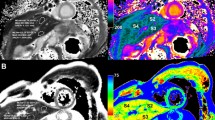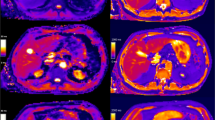Abstract
Objectives
To evaluate hepatic relaxation times T1, T2 and T2* in healthy subjects and patients with liver cirrhosis stratified by the Child-Pugh classification (CPC).
Methods
Sixty-one consecutive patients were stratified by CPC (class A = 26; B = 20; C = 15) and compared with age-matched controls (n = 31). Relaxometry measurements were performed at 1.5 T using six saturation recovery times (200–3,000 ms) to determine liver T1, six echo times (TE 14–113 ms) for T2 and eight TE (4.8–38 ms) for T2* assessment. Signal intensities in selected regions of interest in the liver parenchyma were fitted to theoretical models with least squares minimisation algorithms to determine T1, T2 and T2*.
Results
The most significant difference was the higher T1 values (852 ± 132 ms) in cirrhotic livers compared with controls (678 ± 45 ms, P < 0.0001). A less significant difference was seen for T2* (23 ± 5 vs. 26 ± 7 ms). Subdifferentiation showed a statistically significant difference between control group and individual CPC classes as well as between class C and classes A or B for T1 relaxation times.
Conclusion
Measurement of T1 relaxation time can differentiate healthy subjects from patients with liver cirrhosis, and can distinguish between mild/moderate disease (CPC A/B) and advanced disease (CPC C).
Key Points
• Significantly elevated magnetic resonance T1 relaxation times are found in liver cirrhosis.
• T1 relaxation times can distinguish healthy subjects from patients with liver cirrhosis.
• T1 relaxation times can distinguish Child–Pugh classes A and B from C.






Similar content being viewed by others

References
World Health Organization (2004) The global burden of disease: 2004 update. WHO Press, Geneva
Bolanos-Meade J, Lopez-Arvizu C (2000) Histologic improvement of fibrosis in patients with hepatitis C and sustained response to interferon therapy. Ann Intern Med 133:312
Dixon JB, Bhathal PS, Hughes NR, O’Brien PE (2004) Nonalcoholic fatty liver disease: improvement in liver histological analysis with weight loss. Hepatology 39:1647–1654
Farci P, Roskams T, Chessa L et al (2004) Long-term benefit of interferon alpha therapy of chronic hepatitis D: regression of advanced hepatic fibrosis. Gastroenterology 126:1740–1749
Friedman SL, Bansal MB (2006) Reversal of hepatic fibrosis – fact or fantasy? Hepatology 43:S82–S88
Davis GL, Roberts WL (2010) The healthcare burden imposed by liver disease in aging Baby Boomers. Curr Gastroenterol Rep 12:1–6
Strauss E (2010) Usefulness of liver biopsy in chronic hepatitis C. Ann Hepatol 9(Suppl):39–42
Rockey DC, Caldwell SH, Goodman ZD, Nelson RC, Smith AD (2009) Liver biopsy. Hepatology 49:1017–1044
Pinzani M, Rombouts K, Colagrande S (2005) Fibrosis in chronic liver diseases: diagnosis and management. J Hepatol 42(Suppl):S22–S36
Castera L, Pinzani M (2010) Non-invasive assessment of liver fibrosis: are we ready? Lancet 375:1419–1420
Castera L, Pinzani M (2010) Biopsy and non-invasive methods for the diagnosis of liver fibrosis: does it take two to tango? Gut 59:861–866
Parkes J, Roderick P, Harris S et al (2010) Enhanced liver fibrosis test can predict clinical outcomes in patients with chronic liver disease. Gut 59:1245–1251
McPherson S, Stewart SF, Henderson E, Burt AD, Day CP (2010) Simple non-invasive fibrosis scoring systems can reliably exclude advanced fibrosis in patients with non-alcoholic fatty liver disease. Gut 59:1265–1269
Vizzutti F, Arena U, Nobili V et al (2009) Non-invasive assessment of fibrosis in non-alcoholic fatty liver disease. Ann Hepatol 8:89–94
Molleken C, Sitek B, Henkel C et al (2009) Detection of novel biomarkers of liver cirrhosis by proteomic analysis. Hepatology 49:1257–1266
Bonekamp S, Kamel I, Solga S, Clark J (2009) Can imaging modalities diagnose and stage hepatic fibrosis and cirrhosis accurately? J Hepatol 50:17–35
Hosch W, Bock M, Libicher M et al (2007) MR-relaxometry of myocardial tissue: significant elevation of T1 and T2 relaxation times in cardiac amyloidosis. Invest Radiol 42:636–642
Wang YX, Yuan J, Chu ES et al (2011) T1rho MR imaging is sensitive to evaluate liver fibrosis: an experimental study in a rat biliary duct ligation model. Radiology 259:712–719
Lee MJ, Kim MJ, Yoon CS, Han SJ, Park YN (2011) Evaluation of liver fibrosis with T2 relaxation time in infants with cholestasis: comparison with normal controls. Pediatr Radiol 41:350–354
Keevil SF, Alstead EM, Dolke G, Brooks AP, Armstrong P, Farthing MJ (1994) Non-invasive assessment of diffuse liver disease by in vivo measurement of proton nuclear magnetic resonance relaxation times at 0.08T. Br J Radiol 67:1083–1087
Thomsen C, Christoffersen P, Henriksen O, Juhl E (1990) Prolonged T1 in patients with liver cirrhosis: an in vivo MRI study. Magn Reson Imaging 8:599–604
Pugh RN, Murray-Lyon IM, Dawson JL, Pietroni McWilliams R (1973) Transection of the oesophagus for bleeding oesophageal varices. Br J Surg 60:646–649
Bock M, Schulz J, Ueltzhoeffer S, Giesel F, Voth M, Essig M (2008) Intravascular contrast agent T1 shortening: fast T1 relaxometry in a carotid volunteer study. MAGMA 21:363–368
Wacker CM, Bock M, Hartlep AW et al (1999) Changes in myocardial oxygenation and perfusion under pharmacological stress with dipyridamole: assessment using T*2 and T1 measurements. Magn Reson Med 41:686–695
Bauer WR, Nadler W, Bock M et al (1999) Theory of coherent and incoherent nuclear spin dephasing in the heart. Phys Rev Lett 83:4215–4218
de Certaines JD, Henriksen O, Spisni A, Cortsen M, Ring PB (1993) In vivo measurements of proton relaxation times in human brain, liver, and skeletal muscle: a multicenter MRI study. Magn Reson Imaging 11:841–850
Lerski RA, McRobbie DW, Straughan K, Walker PM, de Certaines JD, Bernard AM (1988) Multi-center trial with protocols and prototype test objects for the assessment of MRI equipment. EEC Concerted Research Project. Magn Reson Imaging 6:201–214
Henriksen O, de Certaines JD, Spisni A, Cortsen M, Muller RN, Ring PB (1993) In vivo field dependence of proton relaxation times in human brain, liver and skeletal muscle: a multicenter study. Magn Reson Imaging 11:851–856
Bernardino ME, Small W, Goldstein J et al (1983) Multiple NMR T2 relaxation values in human liver tissue. AJR Am J Roentgenol 141:1203–1208
Chamuleau RA, Creyghton JH, De Nie I, Moerland MA, Van der Lende OR, Smidt J (1988) Is the magnetic resonance imaging proton spin-lattice relaxation time a reliable noninvasive parameter of developing liver fibrosis? Hepatology 8:217–221
Katsube T, Okada M, Kumano S et al (2011) Estimation of liver function using T1 mapping on Gd-EOB-DTPA-enhanced magnetic resonance imaging. Invest Radiol 46:277–283
Castera L, Sebastiani G, Le Bail B, de Ledinghen V, Couzigou P, Alberti A (2010) Prospective comparison of two algorithms combining non-invasive methods for staging liver fibrosis in chronic hepatitis C. J Hepatol 52:191–198
Kim SU, Han KH, Ahn SH (2010) Non-invasive assessment of liver fibrosis: time to move from cross-sectional studies to longitudinal ones. J Gastroenterol Hepatol 25:1472–1473
Boursier J, Cesbron E, Tropet AL, Pilette C (2009) Comparison and improvement of MELD and Child-Pugh score accuracies for the prediction of 6-month mortality in cirrhotic patients. J Clin Gastroenterol 43:580–585
Shaikh S, Ghani H, Memon S, Baloch GH, Jaffery M, Shaikh K (2010) MELD era: is this time to replace the original Child-Pugh score in patients with decompensated cirrhosis of liver. J Coll Physicians Surg Pak 20:432–435
Foucher J, Chanteloup E, Vergniol J et al (2006) Diagnosis of cirrhosis by transient elastography (FibroScan): a prospective study. Gut 55:403–408
Hashimoto K, Murakami T, Dono K et al (2006) Assessment of the severity of liver disease and fibrotic change: the usefulness of hepatic CT perfusion imaging. Oncol Rep 16:677–683
Acknowledgements
H.U. Kauczor is a consultant for the General Electric Company and received funding for this research from Siemens AG and Boehringer Ingelheim GmbH.
Author information
Authors and Affiliations
Corresponding author
Rights and permissions
About this article
Cite this article
Heye, T., Yang, SR., Bock, M. et al. MR relaxometry of the liver: significant elevation of T1 relaxation time in patients with liver cirrhosis. Eur Radiol 22, 1224–1232 (2012). https://doi.org/10.1007/s00330-012-2378-5
Received:
Revised:
Accepted:
Published:
Issue Date:
DOI: https://doi.org/10.1007/s00330-012-2378-5



